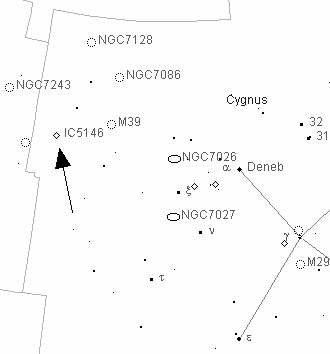The Cocoon Nebula
Jack Kramer
If you savor challenges, then the Cocoon Nebula (IC 5146) in Cygnus will be right up your alley. Although it's listed as 10th magnitude, this is deceptive because it also happens to be relatively large, at 9 arcminutes, so its faint light is spread rather thinly. It requires a sky that is as dark as possible. I suppose that explains why it never made it into Dreyer's New General Catalog (NGC), but had to wait for the later Index Catalog (IC), which generally contains the fainter objects. IC 5146 was visually discovered by Thomas Espin in 1899, with his 171/4-inch Newtonian, while sweeping for double stars.
The following illustration shows where the Cocoon is located. Obviously, you'll need a good chart of your own for star-hopping purposes. A highly detailed chart such as the Uranometria will be especially helpful because it also shows the swath of dark nebulosity that leads to the Cocoon. The dark nebula is primarily interstellar dust that blocks the light from stars beyond it.

My observation of the Cocoon was made with a 10-inch reflector at 75x from the Von Bergen farm near Hebron. It was a very difficult object that required the use of a broadband nebula filter once I had worked my way to the exact position of the nebula. The broadband filter muted the effects of skyglow, while still allowing fairly faint stars to show. Comments from other observers indicate that the Oxygen III narrowband filter doesn't seem to improve the view of this nebula; however, the Cocoon is an object that purportedly responds well to the Lumicon Hydrogen Beta filter. The area is fairly rich with stars, and I first noted the streamer of dark nebulosity (a Barnard object - B168) that terminates at the eastern edge of the Cocoon. Following this streamer, the Cocoon itself was found as several faint blotches of nebulosity.
The Cocoon is interesting from another aspect in that it provides some measure of how light pollution has degraded our ability to see faint objects over the years. In an Internet posting on the amastro eGroup, astronomer Brian Skiff reflected on the circumstances of one observation more than twenty years ago. He notes that in 1977, Chris Luginbuhl observed IC 5146 using just a 60mm Unitron refractor from Flagstaff, Arizona. Note that this was in the era before nebula filters. He lamented about light-pollution, given that others seem to have had difficulty with the nebula using even 10-inch telescopes. The refractor was actually the finder for a 12-inch Cassegrain telescope that was housed on the fifth-floor roof of a building at Northern Arizona University, six blocks from the center of downtown Flagstaff. Chris recorded that his naked-eye limit at the time was around 6.2. His notes for IC 5146 indicate a faint haze around two magnitude 9.5 stars, with a roughly circular shape, about 6'-8' in diameter; an ill-defined dark streak (B168) leads away to the east. Although not specified, the eyepiece used was probably a 32mm war-surplus Erfle that yielded 28x with about a two-degree actual field. (It was one of those that Jaegers used to sell - considered huge in size at the time.)
The fact that it was seen at all with such a small telescope is a testimony to the quality of the sky at Flagstaff back in 1977. My observation from the Von Bergen farm took place in 1990. I suspect that because of encroaching light pollution, today I could no longer locate it from that site with the 10-inch scope.
Published in the August 2000 issue of the NightTimes




